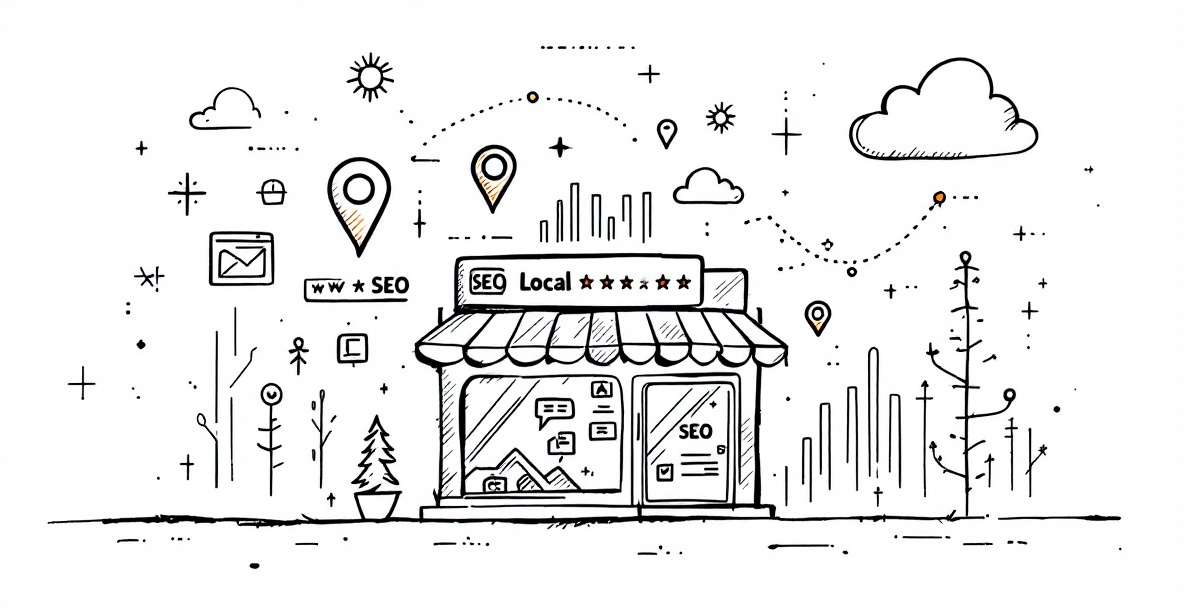Local search dynamics are transforming at an unprecedented pace, creating both challenges and opportunities for businesses focused on driving foot traffic. As we approach 2025, the relationship between digital visibility and physical store visits has become increasingly sophisticated, requiring a strategic approach that extends beyond traditional SEO tactics. With the rise of AI-driven search algorithms, voice search optimization, and hyper-localized user experiences, businesses must adapt their local SEO strategies to remain competitive in their respective markets. This article explores the critical ranking factors that will define local search success in 2025, offering actionable insights for businesses seeking to convert online visibility into measurable foot traffic.
The Evolution of Local Search: Understanding 2025's Digital Landscape

The Shifting Local SEO Paradigm
The local search environment of 2025 barely resembles what marketers knew just a few years ago. Google's algorithm now weighs over 200 factors when determining local rankings, with proximity, relevance, and prominence still forming the core foundation. However, user intent has become the driving force behind search results, with AI interpreting contextual clues that go far beyond keywords.
Voice search now accounts for nearly 55% of local queries, according to recent data from BrightLocal, fundamentally changing how people discover local businesses. Instead of typing "coffee shops downtown," users ask conversational questions like "Where can I get a good cappuccino within walking distance?" This shift demands content that answers natural language questions while maintaining technical optimization.
The integration of augmented reality into search results has created an entirely new dimension for local businesses. Users can now virtually "step inside" establishments before visiting, making visual content and virtual tours essential ranking elements that directly influence foot traffic conversion rates.
Data-Driven Reality: Online Rankings vs. Physical Visits
The correlation between search rankings and physical visits has strengthened significantly. Research from Think with Google shows that 88% of consumers who conduct local searches on mobile devices visit a related store within 24 hours. However, the quality of this traffic now matters more than quantity, with algorithms measuring post-search behaviors like dwell time in-store and purchase completion.
Location data has become increasingly granular, with search engines tracking not just if a user visited after a search, but their entire journey—including stops before and after. This "journey mapping" allows algorithms to better understand which businesses satisfy user intent, creating a feedback loop that rewards businesses whose physical experience matches their digital promise.
Conversion metrics have evolved beyond simple visit counts. The most successful local businesses in 2025 track sophisticated metrics like return visit frequency, cross-channel attribution, and lifetime value of search-originated customers. These data points help algorithms determine which businesses deserve premium placement in local packs and maps results.
Technical Foundation: Building a Local Search Powerhouse

Technical Audit Essentials for Local Visibility
A comprehensive technical SEO audit forms the backbone of effective local search visibility. In 2025's complex search environment, technical excellence is no longer optional but a prerequisite for ranking success. Start with a structured technical seo audit checklist that includes local-specific elements like Google Business Profile optimization, local schema markup implementation, and NAP (Name, Address, Phone) consistency across the web.
Site architecture must support location-specific content without creating duplicate content issues. For multi-location businesses, implementing proper hreflang tags and location-specific URL structures helps search engines understand geographic relevance without diluting domain authority. This becomes particularly important as search engines increasingly factor site structure into local relevance scoring.
Page experience signals now carry significant weight in local rankings. Core Web Vitals performance for location-specific pages directly impacts both rankings and conversion rates. According to a study by Semrush, pages that meet all Core Web Vitals thresholds saw a 70% increase in physical store visits compared to underperforming pages. Focusing on speed optimization, especially for location-specific content, delivers measurable improvements in both visibility and foot traffic.
Mobile-First Local Experience
The convergence of mobile search and local intent has reached its apex in 2025. Over 90% of local searches now happen on mobile devices, making mobile-friendly website design essential for businesses targeting local traffic. This goes beyond responsive layouts to include tap-target sizing, font legibility, and intuitive navigation designed specifically for on-the-go users.
Location-based features must be seamlessly integrated into the mobile experience. One-tap directions, click-to-call functionality, and store hour information should be immediately accessible without requiring additional navigation. The milliseconds saved through these optimizations translate directly to conversion improvements, with Google's data showing that each second of load time reduction increases conversion rates by 20%.
Progressive Web App (PWA) implementation has become standard practice for local businesses serious about driving foot traffic. These applications provide app-like experiences without requiring downloads, offering offline functionality, instant loading, and push notifications. Businesses leveraging PWAs report 50% higher engagement and a 25% increase in return visits, according to research from Web.dev.
Advanced Crawlability Optimization
Search engine crawlers have become increasingly sophisticated in how they discover and interpret local content. Website crawlability improvement techniques now extend beyond basic XML sitemaps to include advanced implementations like dynamic location sitemaps that update automatically with inventory or service availability changes.
Internal linking structures should create clear paths to location pages, with contextual anchor text that reinforces geographic relevance. Strategic internal linking increases crawl efficiency by 40% and helps distribute page authority to location-specific content. This becomes particularly important for businesses with multiple locations competing for visibility in various markets.
JavaScript rendering continues to challenge local SEO efforts, with complex interactive elements often hiding critical local content from search engines. Implementing server-side rendering or dynamic rendering for location-specific interactive elements ensures that crucial information remains crawlable while preserving engaging user experiences that drive conversion.
Content and Authority Signals in Local Search

Local Content Strategy Development
Effective local content in 2025 transcends basic location pages with hours and directions. A comprehensive content creation strategy template should include hyperlocal content that demonstrates genuine community connection. This means creating neighborhood-specific resources that address unique local needs rather than generic city-level content.
Local keyword research advanced methods now incorporate machine learning to identify conversational patterns specific to geographic areas. Tools like SEMrush and Ahrefs have developed regional intent analysis features that uncover how search patterns differ by neighborhood, helping businesses tailor content to match the specific vocabulary and priorities of their exact target market.
User-generated content has emerged as a powerful local ranking signal, with algorithms recognizing authentic customer stories as trust indicators. Businesses that successfully incorporate customer reviews, photos, and experiences into their content strategy see a 35% higher conversion rate from search to visit, according to BrightEdge research. Encouraging and showcasing this content becomes an essential element of local SEO ranking factors.
Authority Building in Local Markets
Authority building digital marketing tactics have evolved beyond simple link acquisition to encompass a holistic approach to local relevance. Earning links from neighborhood associations, local news outlets, and community organizations sends powerful signals to search engines about your geographic authority. These high-value local links often outweigh multiple generic links from non-relevant sources.
Local relevance now extends to your overall link profile. Link building best practices in 2025 prioritize geographic relevance over domain authority metrics alone. A link from a neighboring business with modest domain authority often delivers more local ranking benefit than a link from a high-authority site with no geographic connection to your target area.
Structured local partnerships create authority networks that amplify visibility across related businesses. Cross-promotion between complementary local businesses creates natural authority signals that algorithms recognize as indicators of community integration. These relationships, when documented through proper link attribution and co-citation, create powerful ranking advantages that directly translate to increased foot traffic.
Social Proof and Community Engagement
The boundary between social signals and search rankings has blurred significantly. While Google maintains that social metrics aren't direct ranking factors, the engagement, traffic, and brand awareness generated through effective social channels indirectly boost local visibility. Social media analytics tools now track how social engagement correlates with search visibility and physical visits.
Review management has evolved from a reputation concern to a critical ranking factor. The quantity, quality, recency, and response rate to reviews directly impacts local pack placements. Research from BrightLocal indicates that businesses responding to at least 40% of reviews rank an average of 15 positions higher in local results than those ignoring customer feedback.
Community involvement signals have gained algorithmic weight as search engines better distinguish between genuine local businesses and those merely targeting an area without true community connection. Documentation of event participation, local sponsorships, and community initiatives creates powerful trust signals that influence both rankings and consumer decision-making when choosing local businesses to visit.
Performance Tracking and Optimization

Local SEO Performance Metrics
Traditional SEO metrics like ranking positions and organic traffic provide only part of the local performance picture. Comprehensive seo benchmarking performance metrics for local campaigns should include visibility within map packs, local knowledge panels, and "near me" search results—areas where traditional rank tracking often falls short.
Advanced attribution modeling is essential for understanding which online touchpoints lead to physical visits. Data driven marketing decision making requires connecting online interactions with offline conversions, typically through methods like call tracking, coupon codes, QR scans, or loyalty program enrollments. These connections help businesses determine which ranking improvements actually generate valuable foot traffic.
Competitor benchmarking has evolved to include physical location metrics. A competitive analysis marketing framework should monitor not just digital performance but also comparative foot traffic patterns, using tools like Google's Popular Times data and anonymized mobility reports. This real-world competitive intelligence helps businesses identify opportunities in both their digital strategy and physical operations.
Conversion Tracking for Physical Locations
The gap between digital analytics and physical store metrics has narrowed dramatically. Google Analytics dashboard setup now includes enhanced measurement capabilities that track when searchers who engage with your site later visit your store. This requires proper configuration of both analytics and Google Business Profile to connect these previously separate data streams.
Conversion rate optimization tactics for local businesses must address the entire journey from search to visit. This includes optimizing landing page optimization techniques specifically for local intent queries, with clear location information, compelling reasons to visit, and friction-free conversion paths to directions or appointments.
Email marketing conversion rates for location-based businesses depend heavily on localization and timing. Messages triggered based on proximity or relevant local events generate 72% higher open rates and 187% higher conversion rates than generic broadcasts, according to Campaign Monitor research. Integrating these targeted communications with search visibility creates powerful synergies that drive measurable foot traffic increases.
Customer Journey Analysis
Understanding the complete customer path from initial search to in-store purchase requires sophisticated customer journey mapping processes. Modern journey mapping incorporates touchpoint analysis across search, social, map applications, and in-store experiences to identify critical moments where optimization delivers the highest return on investment.
Attribution modeling has evolved to better connect online behaviors with offline conversions. Advanced marketing automation workflow examples now include location-based triggers that match digital engagement with physical store visits, creating closed-loop reporting that properly credits search visibility for its role in driving foot traffic.
Customer feedback integration completes the analytics picture by adding qualitative insights to quantitative data. Systematic collection of visitor experience information helps identify gaps between search expectations and in-store reality. This feedback loop is crucial for refining both digital presence and physical operations to maximize conversion rates and customer satisfaction.
Future-Proofing Your Local SEO Strategy
Implementation Roadmap
Developing a sustainable local SEO strategy requires a structured approach prioritizing high-impact activities. Begin with a thorough audit covering technical foundation, content quality, and authority signals. This baseline assessment identifies the most critical gaps affecting your current performance and provides clear direction for improvement efforts.
Prioritize implementation based on effort versus impact analysis. Focus first on fundamental technical issues that may be limiting crawlability or preventing proper indexing of location information. These foundational fixes typically deliver the quickest visibility improvements while creating a stable platform for more advanced optimization.
Create a phased rollout plan that builds momentum through early wins. Start with Google Business Profile optimization and NAP consistency corrections, which typically show results within weeks. Progress to technical improvements, content development, and finally authority building activities that deliver compounding benefits over time. This staged approach maintains stakeholder support through regular performance improvements.
Ongoing Optimization Framework
Search engine optimization fundamentals remain crucial even as technology evolves. Establish a regular content refresh schedule that updates location-specific information based on seasonal relevance, service changes, and emerging local search trends. This consistent attention to content currency sends positive freshness signals to search algorithms.
Implement a proactive review management system that encourages feedback, promptly addresses concerns, and leverages positive experiences. The recency and response rate to reviews directly impacts local rankings, making this an essential component of any sustainable local SEO program.
Develop an agile response capability for algorithm updates and emerging technologies. The local search landscape continues to evolve rapidly with each Google update and technology shift. Businesses that maintain flexibility and quickly adapt to these changes maintain competitive advantage. Regular consultation of authoritative resources like SEO Tuts helps businesses stay ahead of these shifts rather than scrambling to catch up after algorithm changes impact visibility.
Local search will continue evolving through 2025 and beyond, with artificial intelligence, augmented reality, and increasingly sophisticated user intent analysis shaping how businesses connect with nearby customers. The most successful organizations will be those that build strong technical foundations, create genuinely helpful local content, establish authentic community connections, and rigorously measure how digital visibility translates to physical visits. By implementing the strategies outlined in this article and maintaining an adaptive approach to emerging trends, businesses can ensure their local SEO efforts drive not just rankings, but the foot traffic that ultimately determines success in local markets.
Leave a Reply